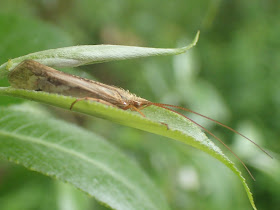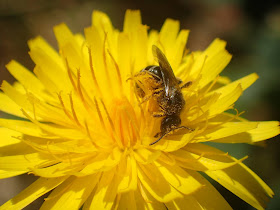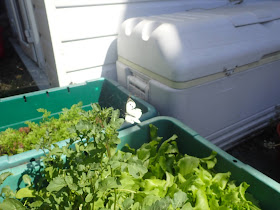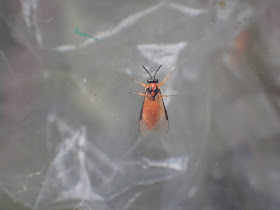7th June 2020
I had carried out the May WeBS count a week late following a relaxation of the lockdown rules (and a change in the BTO advice), but the June count was the first one back on the correct date. The mid-summer counts are often fairly species-poor, but do usually mean large numbers of swans and geese as they gather here for post-breeding moult. Today was no exception, with the number of Canada Geese particularly impressive - I counted 118 although this was an undercount as the shadowy figures of more geese could be seen moving on the main island. Likewise the 179 Greylag Geese, whilst the 117 Mute Swans was probably close to the true amount. Three Common Terns were still present, as was the tame Barnacle Goose. There was a nice flock of hirundines, including overdue first Sand Martins of the year, and some amazing views of Swifts flying along the path, sometimes at waist height.
The weather was showery, which was probably quite handy as it kept the number of other people lower than would have otherwise been the case, but I had initially been disappointed that I wouldn't see as many insects as I would have done if it had been sunny. I needn't have worried, as I found plenty of interest whilst just looking at the vegetation as I made my way round. Highlights included the tortoise beetle Cassida viridis, the caddisfly Limnephilus decipiens, larvae of the sawfly Endelomyia aethiops, an occupied case of the micro-moth Coleophora ibipennella (the latter three species all new to me and the site) and some Mullein moth caterpillars. It was good to be out.
Pages
▼
NORWICH: Garden lockdown list days 74 to 77
DAY 74 - 3rd June 2020
153. Phytomyza ranunculi - a leaf mine in Creeping Buttercup
DAY 75 - 4th June 2020
154. Ischnus inquisitorius (an ichneumon). I was fortunate that the photo allowed national expert Gavin Broad to identify this one on Twitter.
155. Oak Bush Cricket
DAY 76 - 5th June 2020
A couple of leafmines added, but also several species seen at different stages of their life to earlier in the year . Firstly the sawfly Cladius bruillei - I keyed out an adult earlier but now the larvae are stripping the leaves from the Raspberries. Then the reverse, with an adult Cypress-tip Moth, previously seen as feeding sign holes in cypress shoots.
156. Agromyza idaeana (leaf mine in Strawberry)
157. Agromyza abiens (leaf mine in Viper's Bugloss)
DAY 77 - 6th June 2020
Nothing new added but I was pleased with this photo of Meliscaeva auricollis on a Rocket flower.
153. Phytomyza ranunculi - a leaf mine in Creeping Buttercup
DAY 75 - 4th June 2020
154. Ischnus inquisitorius (an ichneumon). I was fortunate that the photo allowed national expert Gavin Broad to identify this one on Twitter.
155. Oak Bush Cricket
DAY 76 - 5th June 2020
A couple of leafmines added, but also several species seen at different stages of their life to earlier in the year . Firstly the sawfly Cladius bruillei - I keyed out an adult earlier but now the larvae are stripping the leaves from the Raspberries. Then the reverse, with an adult Cypress-tip Moth, previously seen as feeding sign holes in cypress shoots.
156. Agromyza idaeana (leaf mine in Strawberry)
157. Agromyza abiens (leaf mine in Viper's Bugloss)
DAY 77 - 6th June 2020
Nothing new added but I was pleased with this photo of Meliscaeva auricollis on a Rocket flower.
NORWICH: Garden lockdown list day 73
DAY 73 - 2nd June 2020
Another five new species for the lockdown garden list saw me break through the 150 mark. Of these the highlight was a new bee for me, White-zoned Furrow Bee, feeding on the Catsear in the lawn. The other species were Sage Leafhopper, Meliscaeva auricollis, Small Dusty Wave and Field Grasshopper.
148. White-zoned Furrow Bee (Lasioglossum leucozonium)
149. Sage Leafhopper
150. Meliscaeva auricollis
151. Small Dusty Wave
152. Field Grasshopper.
Another five new species for the lockdown garden list saw me break through the 150 mark. Of these the highlight was a new bee for me, White-zoned Furrow Bee, feeding on the Catsear in the lawn. The other species were Sage Leafhopper, Meliscaeva auricollis, Small Dusty Wave and Field Grasshopper.
148. White-zoned Furrow Bee (Lasioglossum leucozonium)
149. Sage Leafhopper
150. Meliscaeva auricollis
151. Small Dusty Wave
152. Field Grasshopper.
NORWICH: Garden lockdown list day 72 - an egg-laying butterfly
DAY 72 - 1st June 2020
The undoubted highlight of today was watching a Large White butterfly laying eggs on the Rocket plants (ideally it would have been on some of the wild mustard plants rather than our salad, but hey-ho). Having initially seen it from indoors, Rose & I went outside and we were able to watch it flying around and occasionally laying an egg. Afterwards I had a hunt and managed to locate several of them. The hoverfly Helophilus pendulus and 14-spot ladybird were new for the lockdown list.
147. 14-spot Ladybird
NORWICH: Garden lockdown list day 71 - Denticulated Leatherbug
DAY 71 - 31st May 2020
The government had announced that from 1st June lockdown restrictions would be relaxed somewhat. Trips out would be allowed for recreation rather than exercise, so basically there would no longer be the presumption that you should stay at home, however people should still work from home if they can. It was quite a nuanced mesage, made harder by the quite stupid sounding 'stay alert' message. Anyway, you could make an argument that 31st May was the last day of 'proper' lockdown, but I'll carry on labelling the posts as such for a while yet.
Today in the garden there was great excitement with the sighting of a frog. There was no spawn in the pond this year, but we hope that maybe next year there might be. A couple of new hoverflies were in the garden, Myathropa florea and Syritta pipiens, but the undoubted highlight for me was a leatherbug found by Rose - Denticulated Leatherbug. I was able to have a close up look at this spiky little species, which I had only previously seen on one occasion at Minsmere.
142. Common Frog
143. Mythropa florea (a hoverfly)
144. Syritta pipiens (a hoverfly)
145. Denticulated Leatherbug.
The government had announced that from 1st June lockdown restrictions would be relaxed somewhat. Trips out would be allowed for recreation rather than exercise, so basically there would no longer be the presumption that you should stay at home, however people should still work from home if they can. It was quite a nuanced mesage, made harder by the quite stupid sounding 'stay alert' message. Anyway, you could make an argument that 31st May was the last day of 'proper' lockdown, but I'll carry on labelling the posts as such for a while yet.
Today in the garden there was great excitement with the sighting of a frog. There was no spawn in the pond this year, but we hope that maybe next year there might be. A couple of new hoverflies were in the garden, Myathropa florea and Syritta pipiens, but the undoubted highlight for me was a leatherbug found by Rose - Denticulated Leatherbug. I was able to have a close up look at this spiky little species, which I had only previously seen on one occasion at Minsmere.
142. Common Frog
143. Mythropa florea (a hoverfly)
144. Syritta pipiens (a hoverfly)
145. Denticulated Leatherbug.
NORWICH AREA: A short walk at Arminghall
30th May 2020
I wanted to go out for a short walk at the weekend, but rather than going to Whitlingham I decided to head a few miles down the road to Arminghall. A couple of other naturalists had seen lots of insects along this stretch of the Boudicca Way, including several rare bees, so given its proximity to the city it seemed like a good idea. Upon arrival there was an impressive display of Milk Thistles, and lots of mating Fairy-ring Longhorn Beetles on Ox-eye Daisies. Skylarks sang, Buzzards soared, it was a lovely (albeit already quite hot) day.
I walked along the cross-field path towards the hedgerow, then followed it uphill with the quarry to my right. I started checking the umbellifers and brambles, and managed to see several examples of Andrena proxima, a scarce species in Norfolk, but not it's even rarer nomad bee which had been seen in the past week. I did notice quite a few different species of sawfly, including Tenthredo mesomela, a new one for me.
I had a quick check along a shady bit of path too, and this paid off when I found a couple of cases of the micro moth Coleophora badiipennella on hedgerow Elms. Aware that Cathy and Rose were still at home I retraced me steps, but before heading home I searched along the hedgerow, aware that there was meant to be some Small Eggar caterpillars in the area. I managed to find a web of them, which was pleasing as although I've seen both the adult and caterpillar of Oak Eggar, Small Eggar was a new one for me.
NORWICH: Garden lockdown list - days 68 - 70
DAY 68 - 27th May 2020
Nothing new added.
DAY 69 - 28th May 2020
Another check of the Pyrocantha blossom, which is excellent for insects but goes over very quickly, providing about a week of high quality insect food. There was one new species on it today, a Garden Chafer (a small relative of the Cockchafer that is also common around this time of year, although not recorded from the garden so far).
136. Garden Chafer
DAY 70 - 29th May 2020
A mini-flurry of new lockdown species today. Having missed off Black Medick leaves from the plant list, I added it today with the first patch in flower. There were some Chromatomyia horticola leaf mines in the Purple Toadflax, whilst the hoverfly Merodon equestris and Yellow Shell moth were both seen flying around. Finally the spider Philodromus dispar was on one of the vegetable boxes.
137. Black Medick
138. Chromatomyia horticola (a leaf mining fly)
139. Merodon equestris (a hoverfly)
140. Yellow Shell (a moth)
141. Philodromus dispar (a spider)
Nothing new added.
DAY 69 - 28th May 2020
Another check of the Pyrocantha blossom, which is excellent for insects but goes over very quickly, providing about a week of high quality insect food. There was one new species on it today, a Garden Chafer (a small relative of the Cockchafer that is also common around this time of year, although not recorded from the garden so far).
136. Garden Chafer
DAY 70 - 29th May 2020
A mini-flurry of new lockdown species today. Having missed off Black Medick leaves from the plant list, I added it today with the first patch in flower. There were some Chromatomyia horticola leaf mines in the Purple Toadflax, whilst the hoverfly Merodon equestris and Yellow Shell moth were both seen flying around. Finally the spider Philodromus dispar was on one of the vegetable boxes.
137. Black Medick
138. Chromatomyia horticola (a leaf mining fly)
139. Merodon equestris (a hoverfly)
140. Yellow Shell (a moth)
141. Philodromus dispar (a spider)
WHITLINGHAM SPECIES GUIDES
A sort of lethargy has prevented me from ever properly catching up on my garden blog entries - I will get there eventually!
In the mean time I'm promoting my Whitlingham Species Guides again. During the strictest part of lockdown I did quite a bit of work on these, adding some species, making the layout a bit more uniform and writing some new ones. If you haven't seen them before then they are a mixture of guides and checklists, aiming to eventually cover all of the wildlife that has been recorded on my patch. There are several reasons for doing this:
The guides can be found on the species guides tab on the blog (https://jamesbirdsandbeer.blogspot.com/p/whitlingham-do.html)
Recent guides include arachnids, plant bugs and leafhoppers, whilst there have been large updates to hoverflies (thanks mainly to some excellent new records from Anne Crotty) and several other guides.
In the mean time I'm promoting my Whitlingham Species Guides again. During the strictest part of lockdown I did quite a bit of work on these, adding some species, making the layout a bit more uniform and writing some new ones. If you haven't seen them before then they are a mixture of guides and checklists, aiming to eventually cover all of the wildlife that has been recorded on my patch. There are several reasons for doing this:
- To make sure there is a publically accessible list of wildlife records for the area
- To help other naturalists ID things they are not familiar with
- To encourage people to submit records of wildlife from Whitlingham
- To encourage people to undertake similar recording projects on their own local patches
The guides can be found on the species guides tab on the blog (https://jamesbirdsandbeer.blogspot.com/p/whitlingham-do.html)
Recent guides include arachnids, plant bugs and leafhoppers, whilst there have been large updates to hoverflies (thanks mainly to some excellent new records from Anne Crotty) and several other guides.
NORWICH: Slender-horned Leatherbug
26th May 2020
A slow walk into work, and although the traffic levels are creeping back up it was still much quieter than would be normal (most of the city centre car parks are still shut). I heard screeching swifts above and a singing Goldcrest in a roadside conifer, whilst Banded Demoiselles and Large Red Damselflies fluttered over the river. Some Common Broomrape had once again grown near the path, presumably parasitizing the nearby Buddleia.
The highlight was reserved for my return journey however, when I noticed a Coreid bug on a leaf. It looked similar to Box Bug, but was noticeably smaller and the corners of the pronotum didn't stick out as far as they would on that species. I photographed it from several angles and was delighted to identify it as Slender-horned Leatherbug. I'd not seen this species before, and it means that there are just two more Leatherbugs that occur in East Anglia left for me to see - Cryptic Leatherbug and Dalman's Leatherbug. The latter does occur in the Brecks, but I've not heard of any recent sightings of the former.
NORWICH : Garden lockdown list - days 62 to 67
DAY 62 - 21st May to DAY 64 23rd May 2020
Nothing new added
DAY 65 - 24th May 2020
Whilst out in the garden we stopped to listen to the Blue Tits in the nest box. For the last week or so we have been able to hear the young when close to the box, but it was clear that they were nearly ready to fledge.
DAY 66 - 25th May 2020
We had hoped to be able to watch the Blue Tits fledge at some point, but the adults weren't flying in and it was suspiciously quiet. They must have fledged shortly after dawn and been shepherded out of the garden. A shame that we didn't get to show Rose 'her' baby birds, but probably for the best given that a cat and two Magpies had been paying close attention to the nest box.
DAY 67 - 26th May 2020
The Pyrocantha that grows along the front wall of the house was in full flower, so I had a look on my return from work and added a few bits and bobs. A couple of Germander Speedwell flowers had come up in the lawn, whilst I also noticed some Broad-leaved Dock.
132. Honey Bee
133. Anthocomus fasciatus (NEW) (a beetle)
134. Germander Speedwell
135. Broad-leaved Dock
Nothing new added
DAY 65 - 24th May 2020
Whilst out in the garden we stopped to listen to the Blue Tits in the nest box. For the last week or so we have been able to hear the young when close to the box, but it was clear that they were nearly ready to fledge.
DAY 66 - 25th May 2020
We had hoped to be able to watch the Blue Tits fledge at some point, but the adults weren't flying in and it was suspiciously quiet. They must have fledged shortly after dawn and been shepherded out of the garden. A shame that we didn't get to show Rose 'her' baby birds, but probably for the best given that a cat and two Magpies had been paying close attention to the nest box.
DAY 67 - 26th May 2020
The Pyrocantha that grows along the front wall of the house was in full flower, so I had a look on my return from work and added a few bits and bobs. A couple of Germander Speedwell flowers had come up in the lawn, whilst I also noticed some Broad-leaved Dock.
132. Honey Bee
133. Anthocomus fasciatus (NEW) (a beetle)
134. Germander Speedwell
135. Broad-leaved Dock
WHITLINGHAM: Regal Piercer
23rd May 2020
Whitlingham was quite busy so I decided to just have a quick walk around the picnic meadow edge to look for insects. Highlight of the visit was a new micro moth, Regal Piercer (Pammene regiana), but there was a decent range of other things, including the hoverfly Xanthogramma pedisequum, which is always nice to see.
Whitlingham was quite busy so I decided to just have a quick walk around the picnic meadow edge to look for insects. Highlight of the visit was a new micro moth, Regal Piercer (Pammene regiana), but there was a decent range of other things, including the hoverfly Xanthogramma pedisequum, which is always nice to see.
THORPE MARSHES: Corncrake
Late May 2020
Despite lockdown, or perhaps because of it, there had been a good range of bird species recorded from Norwich this spring. Corncrake was probably still one of the least expected, so when one was found calling at Thorpe Marshes it understandably caused quite a bit of interest. It is highly likely that it is one of the birds released in the Wensum Valley by Pensthorpe as part of their reintroduction project, albeit that still means that it is likely to have made the migration to Africa and back which is no mean feat. I hadn't twitched anything over the strictest part of the lockdown, and had also resisted going to hear a Quail in west Norwich a few days before, but the fact that it was on my patch made me at least want to go and hear the Corncrake (a few lucky people have seen it, but it doesn't seem to show with any regularity). In the end I went to Thorpe Marshes one evening, and after a nervous wait listening to the Grasshopper Warblers the Corncrake finally started calling. It seems quite settled, so who knows, maybe next year it will attract a friend?
I contacted Pensthorpe monitoring team just to check they knew about it, and one of the ringers in the project confirmed that they were assuming it was one of theirs. The publicity document states that in 2016 69 birds were released (32 males) and in 2017 it was 154 (68 males) but I haven't heard back about the number of releases in 2018 or 2019 - if you know then please get in touch as that would be useful background information.
NORWICH: Garden lockdown list days 60 & 61
DAY 60 - 19th May 2020
Whilst inside we could see some insects flying around outside. Going to check I found a swarm of Turnip Sawflies (Athalia rosae), at least 50 strong. These seemed to have arrived early afternoon, and had mostly gone by the previous day (with the exception of several that had flown into spider webs).
126. Turnip Sawfly (Athalia rosae)
DAY 61 - 20th May 2020
Rose has developed a liking for woodlice, so today we got a white tray out and went through some leaf litter to have a look at them, finding the same two species as before (Common Striped and Rough Woodlouse). Whilst doing this though I did notice a small bug, which although similar to several other species I am confident is Scolopostethus affinis. I also noticed a beetle in the grass, which looked familiar. It took me a while as I'm used to seeing them in blossom, but it turned out it was Common Grammoptera, a longhorn beetle. A few other random bits were added too, detailed below.
127. Scolopostethus affinis (a groundbug)
128. Common Grammoptera (Longhorn Beetle)
129. Beaked Hawksbeard
130. Neoerysiphe galeopsidis (mildew on Bugle)
131. Aceria macrorhyncha (nail galls on Sycamore)
Whilst inside we could see some insects flying around outside. Going to check I found a swarm of Turnip Sawflies (Athalia rosae), at least 50 strong. These seemed to have arrived early afternoon, and had mostly gone by the previous day (with the exception of several that had flown into spider webs).
126. Turnip Sawfly (Athalia rosae)
DAY 61 - 20th May 2020
Rose has developed a liking for woodlice, so today we got a white tray out and went through some leaf litter to have a look at them, finding the same two species as before (Common Striped and Rough Woodlouse). Whilst doing this though I did notice a small bug, which although similar to several other species I am confident is Scolopostethus affinis. I also noticed a beetle in the grass, which looked familiar. It took me a while as I'm used to seeing them in blossom, but it turned out it was Common Grammoptera, a longhorn beetle. A few other random bits were added too, detailed below.
127. Scolopostethus affinis (a groundbug)
128. Common Grammoptera (Longhorn Beetle)
129. Beaked Hawksbeard
130. Neoerysiphe galeopsidis (mildew on Bugle)
131. Aceria macrorhyncha (nail galls on Sycamore)


















































